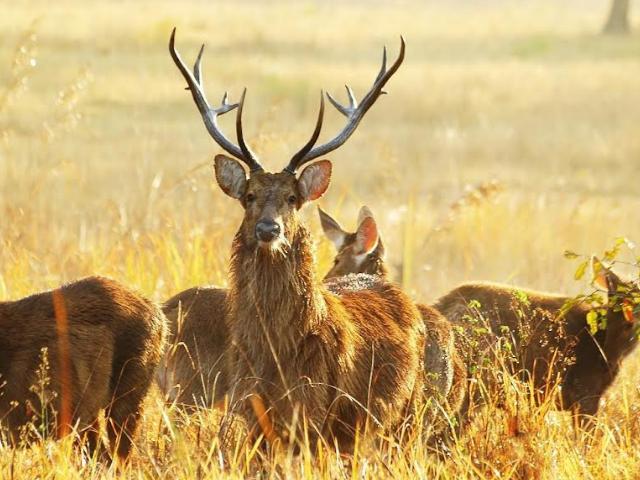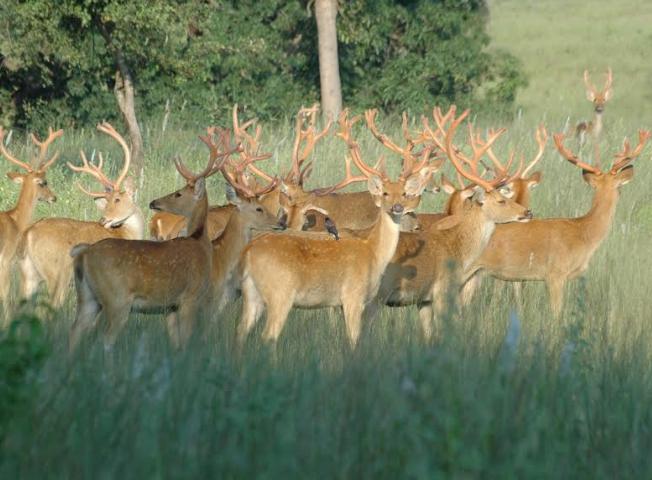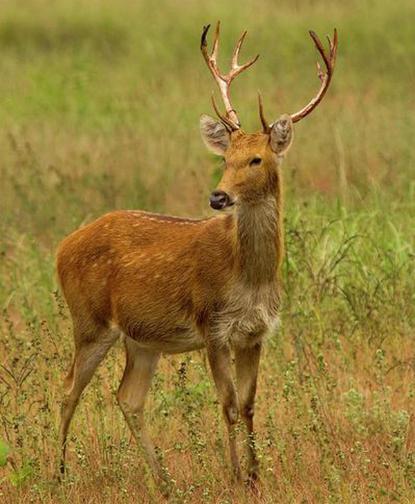[ad_1]
World famous Kanha National Park has achieved another milestone. Population of vulnerable Barasingha, the hard-ground swamp deer (Rucervus duvaucelii branderi) has crossed the 1000 mark recently . Kanha may be known for tiger and its conservation work; the park is credited with persistent protection work for the vulnerable deer on the brink. Barasingha is also the state animal of Madhya Pradesh, the state known for housing the maximum number of tigers. Kanha is the only place in the world to see the magnificent hard-ground swamp deer in the wild in all its glory.
Kahna Meadows Come Alive
Though the swamp deer keep the jungle alive with their activities throughout the year, they are very active from winters to monsoon . When the national parks are closed down for monsoon, the frontline staff of Kanha face the challenge of not only protecting tigers by patrolling the jungle but also look after Barasingha as monsoon is the breeding period of this elusive and shy animal. The grasslands of Kanha , the swamp and the water bodies around are abuzz with Barasingha activities. Towards the end of monsoon, Barasingha gives birth. Swamp deer give birth to only one fawn every year and the survival rate is low. They prefer grassland, the Kanha meadows to hide and not the forest. The fawns of Barasingha deer have spots on their body and the young ones resemble spotted deer. “These spots help them escape predators and work as a wonderful camouflage in the grass. These spots gradually disappear by the age of one”, says S K Singh, field director of Kanha national park , which sprawls over 940 square km over Mandla and Balaghat districts in the central India state of Madhya Pradesh . Almost 8 % of the core zone of the park is developed as grassland.
Also read: Monsoon Magic At Bandhavgarh Tiger Reserve
Earlier in the winters, Barasingha plays a characteristic behaviour of rutting. Stags display and battle each other for breeding access to females. Loud vocalisation and sparring at each other are typical of ruts. The gestation period is long and lasts 8 months leading to birth in the end of the monsoon. The tall grass growths help them survive. It is a wonderful sight to watch the deer when they stand tall in a Kanha golden sunlit Kanha meadow. The sun rays produce a magical effect on the wooly coat as it glitters in golden light. Kanha is unique in the sense that the swamp activities are exclusive to the park only. Kanha Tiger Reserve is the only place in the wild where Hard-ground Barasingha can be found. A small population is translocated to Satpura Tiger Reserve but it is very small in number.
Over 50 Years of Conservation Efforts
Identified as a large deer with a woolly golden-hued coat, the Barasingha swamp deer gets its name from the many tines on an adult male’s antlers. “Barasingha” in Hindi means “12-tined”. Stags can actually have up to 20 tines, which give them a very majestic and royal look. It was very close to extinction when a successful breeding program and conservation practices at Kanha National Park revived its population. The species is still on the vulnerable list after numbers fell drastically in the mid-20th century. Encroachment on their habitat, poaching, and disease all led to the drastic decline in numbers.
Also read: Jungle Book Comes Alive in Pench Tiger Reserve
There were only about 60 individuals left in the national park when the conservation program started in the early 1970s. It took almost 50 years to revive the population to this level. Along with the beautiful Barasingha, there is an abundance of other animals and birds one can enjoy seeing at Kanha National Park. These include hordes of spotted deer, dhole (wild dog) , gaur, golden jackals, langurs, and, of course, the majestic tiger .tigers. The tiger population in Kanha, and elsewhere in India, is on the rise, and the reserve is one of the best places in the country to see one in the wild.
Kanha To Open From October 1
Kanha national park will reopen from October 1. Safari bookings are on and a large number of visitors is expected again after the three months of monsoon break from June to September. In the past, the park would be closed till October 30 which was benefitting the Barasinghas the most. The Barasingha is a Kanha success story, which the park celebrated in 2017 by becoming the first tiger reserve in India to officially introduce a mascot: Boorsingh the Barasingha.
Also read:Tiger Boom of Panna: River Project To Lead Reversal of The Trend
Three subspecies of southern swamp deer are found in the Indian subcontinent. These are the western swamp deer found in Nepal, southern swamp deer (found in central & north India), and eastern swamp deer found in Kaziranga national park in Assam and Dudhwa National Park in Uttar Pradesh. Of these, the southern swamp deer have hard hooves and are adapted to hard ground, while the other two species are found in swampy areas
Images courtsey Kanha National Park
[ad_2]
Source link





